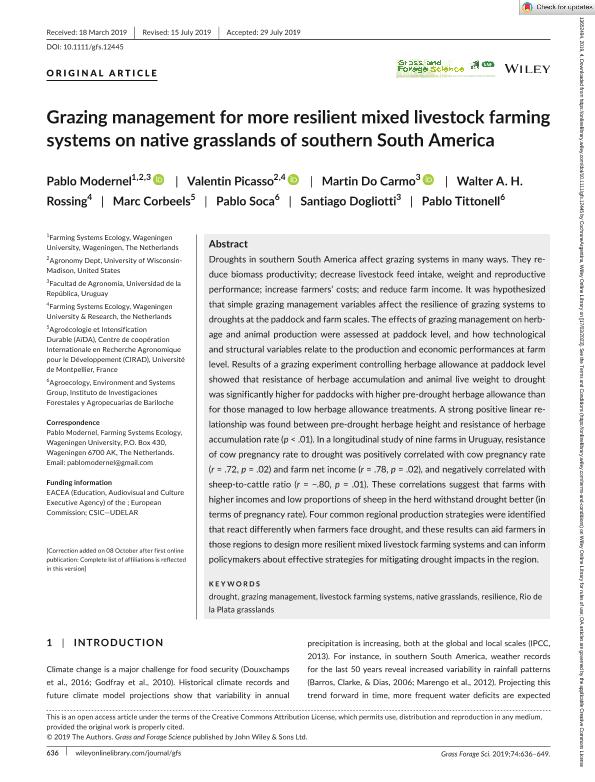Mostrar el registro sencillo del ítem
dc.contributor.author
Modernel, Pablo
dc.contributor.author
Picasso, Valentin
dc.contributor.author
Do Carmo, Martin
dc.contributor.author
Rossing, Walter A. H.
dc.contributor.author
Corbeels, Marc
dc.contributor.author
Soca, Pablo
dc.contributor.author
Dogliotti, Santiago
dc.contributor.author
Tittonell, Pablo

dc.date.available
2023-08-24T14:10:19Z
dc.date.issued
2019-12
dc.identifier.citation
Modernel, Pablo; Picasso, Valentin; Do Carmo, Martin; Rossing, Walter A. H.; Corbeels, Marc; et al.; Grazing management for more resilient mixed livestock farming systems on native grasslands of southern South America; Wiley Blackwell Publishing, Inc; Grass and Forage Science; 74; 4; 12-2019; 636-649
dc.identifier.issn
0142-5242
dc.identifier.uri
http://hdl.handle.net/11336/209242
dc.description.abstract
Droughts in southern South America affect grazing systems in many ways. They reduce biomass productivity; decrease livestock feed intake, weight and reproductive performance; increase farmers’ costs; and reduce farm income. It was hypothesized that simple grazing management variables affect the resilience of grazing systems to droughts at the paddock and farm scales. The effects of grazing management on herbage and animal production were assessed at paddock level, and how technological and structural variables relate to the production and economic performances at farm level. Results of a grazing experiment controlling herbage allowance at paddock level showed that resistance of herbage accumulation and animal live weight to drought was significantly higher for paddocks with higher pre-drought herbage allowance than for those managed to low herbage allowance treatments. A strong positive linear relationship was found between pre-drought herbage height and resistance of herbage accumulation rate (p <.01). In a longitudinal study of nine farms in Uruguay, resistance of cow pregnancy rate to drought was positively correlated with cow pregnancy rate (r =.72, p =.02) and farm net income (r =.78, p =.02), and negatively correlated with sheep-to-cattle ratio (r = −.80, p =.01). These correlations suggest that farms with higher incomes and low proportions of sheep in the herd withstand drought better (in terms of pregnancy rate). Four common regional production strategies were identified that react differently when farmers face drought, and these results can aid farmers in those regions to design more resilient mixed livestock farming systems and can inform policymakers about effective strategies for mitigating drought impacts in the region.
dc.format
application/pdf
dc.language.iso
eng
dc.publisher
Wiley Blackwell Publishing, Inc

dc.rights
info:eu-repo/semantics/openAccess
dc.rights.uri
https://creativecommons.org/licenses/by/2.5/ar/
dc.subject
DROUGHT
dc.subject
GRAZING MANAGEMENT
dc.subject
LIVESTOCK FARMING SYSTEMS
dc.subject
NATIVE GRASSLANDS
dc.subject
RESILIENCE
dc.subject
RIO DE LA PLATA GRASSLANDS
dc.subject.classification
Ganadería

dc.subject.classification
Producción Animal y Lechería

dc.subject.classification
CIENCIAS AGRÍCOLAS

dc.title
Grazing management for more resilient mixed livestock farming systems on native grasslands of southern South America
dc.type
info:eu-repo/semantics/article
dc.type
info:ar-repo/semantics/artículo
dc.type
info:eu-repo/semantics/publishedVersion
dc.date.updated
2023-08-15T23:09:29Z
dc.journal.volume
74
dc.journal.number
4
dc.journal.pagination
636-649
dc.journal.pais
Reino Unido

dc.journal.ciudad
Londres
dc.description.fil
Fil: Modernel, Pablo. Universidad de la República; Uruguay. University of Agriculture Wageningen; Países Bajos. University of Wisconsin; Estados Unidos
dc.description.fil
Fil: Picasso, Valentin. University of Agriculture Wageningen; Países Bajos. University of Wisconsin; Estados Unidos
dc.description.fil
Fil: Do Carmo, Martin. Universidad de la República; Uruguay
dc.description.fil
Fil: Rossing, Walter A. H.. University of Agriculture Wageningen; Países Bajos
dc.description.fil
Fil: Corbeels, Marc. Université Montpellier II; Francia
dc.description.fil
Fil: Soca, Pablo. Instituto Nacional de Tecnología Agropecuaria. Centro Regional Patagonia Norte. Estación Experimental Agropecuaria San Carlos de Bariloche. Instituto de Investigaciones Forestales y Agropecuarias Bariloche. - Consejo Nacional de Investigaciones Científicas y Técnicas. Centro Científico Tecnológico Conicet - Patagonia Norte. Instituto de Investigaciones Forestales y Agropecuarias Bariloche; Argentina
dc.description.fil
Fil: Dogliotti, Santiago. Universidad de la Republica; Uruguay
dc.description.fil
Fil: Tittonell, Pablo. Instituto Nacional de Tecnología Agropecuaria. Centro Regional Patagonia Norte. Estación Experimental Agropecuaria San Carlos de Bariloche. Instituto de Investigaciones Forestales y Agropecuarias Bariloche. - Consejo Nacional de Investigaciones Científicas y Técnicas. Centro Científico Tecnológico Conicet - Patagonia Norte. Instituto de Investigaciones Forestales y Agropecuarias Bariloche; Argentina
dc.journal.title
Grass and Forage Science

dc.relation.alternativeid
info:eu-repo/semantics/altIdentifier/doi/http://dx.doi.org/10.1111/gfs.12445
dc.relation.alternativeid
info:eu-repo/semantics/altIdentifier/url/https://onlinelibrary.wiley.com/doi/10.1111/gfs.12445
Archivos asociados
